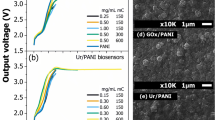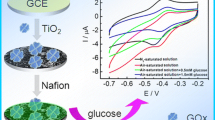Abstract
The D-trehalose/D-maltose-binding protein (TMBP), a monomeric protein of 48 kDa, is one component of the trehalose and maltose (Mal) uptake system. In the hyperthermophilic archaeon Thermococcus litoralis, this is mediated by a protein-dependent ATP-binding cassette system transporter. The gene coding for a thermostable TMBP from the archaeon T. litoralis has been cloned, and the recombinant protein has been expressed in E. coli. The recombinant TMBP has been purified to homogeneity and characterized. It exhibits the same functional and structural properties as the native one. In fact, it is highly thermostable and binds sugars, such as maltose, trehalose and glucose, with high affinity. In this work, we have immobilized TMBP on a porous silicon wafer. The immobilization of TMBP to the chip was monitored by reflectivity and Fourier Transformed Infrared spectroscopy. Furthermore, we have tested the optical response of the protein-Chip complex to glucose binding. The obtained data suggest the use of this protein for the design of advanced optical non-consuming analyte biosensors for glucose detection.





Similar content being viewed by others
References
Bradford MM (1976) A rapid and sensitive method for the quantitation of microgram quantities of protein utilizing the principle of protein-dye binding. Anal Biochem 72:248–254
Brock TD (1985) Life at high temperatures. Science 239:132–138
D’Auria S, Moracci M, Febbraio F, Tanfani F, Nucci R, Rossi M (1998) Structure-function studies on β-glycosidase from Sulfolobus solfataricus. Molecular bases of thermostability. Biochemie 80:949–957
Diez J, Diederichs K, Greller G, Horlacher R, Boos W, Welte W (2001) The crystal structure of a liganded trehalose/maltose-binding protein from the hyperthermophilic archaeon Thermococcus litoralis at 1.85 A. J Mol Biol 305:905–915
Herman P, Staiano M, Marabotti A, Varriale A, Scirè A, Tanfani F, Vecer J, Rossi M, D’Auria S (2006) d-Trehalose/d-maltose-binding protein from the hyperthermophilic archaeon Thermococcus litoralis: The binding of trehalose and maltose results in different protein conformational states. Proteins Struct Func Bioinform 63:754–767
Horlacher R, Xavier KB, Santos H, DiRuggiero J, Kossmann M, Boos W (1998) Archaeal binding protein-dependent ABC transporter: molecular and biochemical analysis of the trehalose/maltose transport system of the hyperthermophilic archaeon Thermococcus litoralis. J Bacteriol 180:680–689
Jaenicke R (1994) Studies on hyperstable proteins: crystallins from the eye-lens and enzymes from thermophilic bacteria. In: Doniach S (ed) Statistical mechanics, protein structure, and protein substrate interactions. Plenum, New York, pp 49–62
Sun YJ, Rose J, Wang BC, Hsiao CD (1998) The structure of glutamine-binding protein complexed with glutamine at 1.94 angstrom resolution: comparisons with other amino acid binding proteins. J Mol Biol 278:219–222
Xavier KB, Martins LO, Peist R, Kossmann M, Boos W, Santos H (1996) High-affinity maltose/trehalose transport system in the hyperthermophilic archaeon Thermococcus litoralis. J Bacteriol 178:4773–4777
Acknowledgments
The authors thank Dr. Fabienne Chevance, University of Utah, Salt Lake City, USA, and Prof. Winfried Boos, University of Konstanz, Germany, for supplying a partially purified protein sample. This work is in the frame of the project “Diagnostica Avanzata ed Alimentazione” CNR Commessa of the Agro-Food Department (SD). This work was also supported by the ASI project MoMa No. 1/014/06/0 (SD) and by a grant from the Ministero degli Affari Esteri, Direzione Generale per la Promozione e la Cooperazione Culturale (SD).
Author information
Authors and Affiliations
Corresponding author
Additional information
Communicated by D. A. Cowan.
The authors wish to dedicate this work to Prof. Ignacy Gryczynski, University of North Texas, TX, USA, for his outstanding contribution to the development of new sensing methodologies.
Rights and permissions
About this article
Cite this article
De Stefano, L., Vitale, A., Rea, I. et al. Enzymes and proteins from extremophiles as hyperstable probes in nanotechnology: the use of D-trehalose/D-maltose-binding protein from the hyperthermophilic archaeon Thermococcus litoralis for sugars monitoring. Extremophiles 12, 69–73 (2008). https://doi.org/10.1007/s00792-006-0058-6
Received:
Accepted:
Published:
Issue Date:
DOI: https://doi.org/10.1007/s00792-006-0058-6




